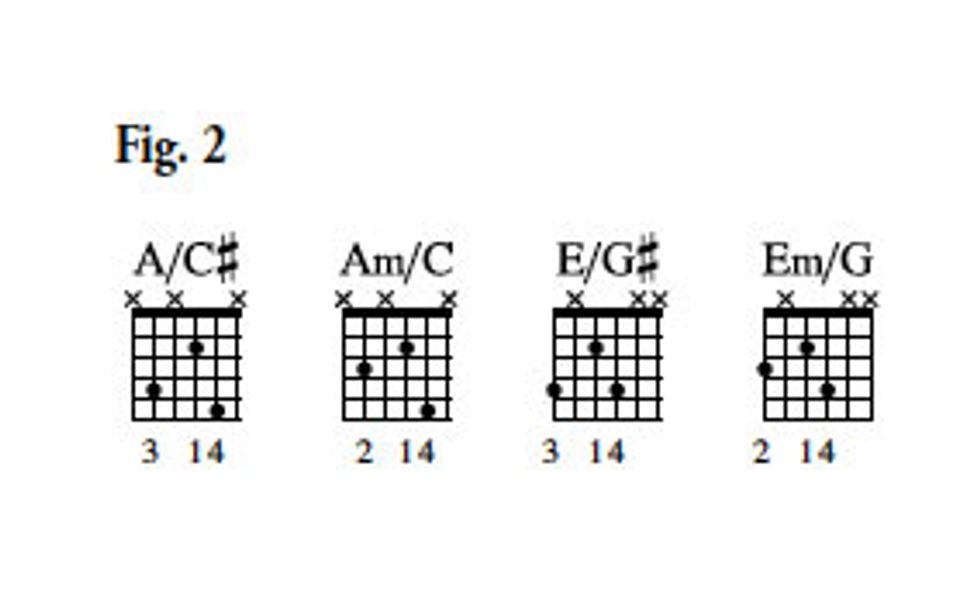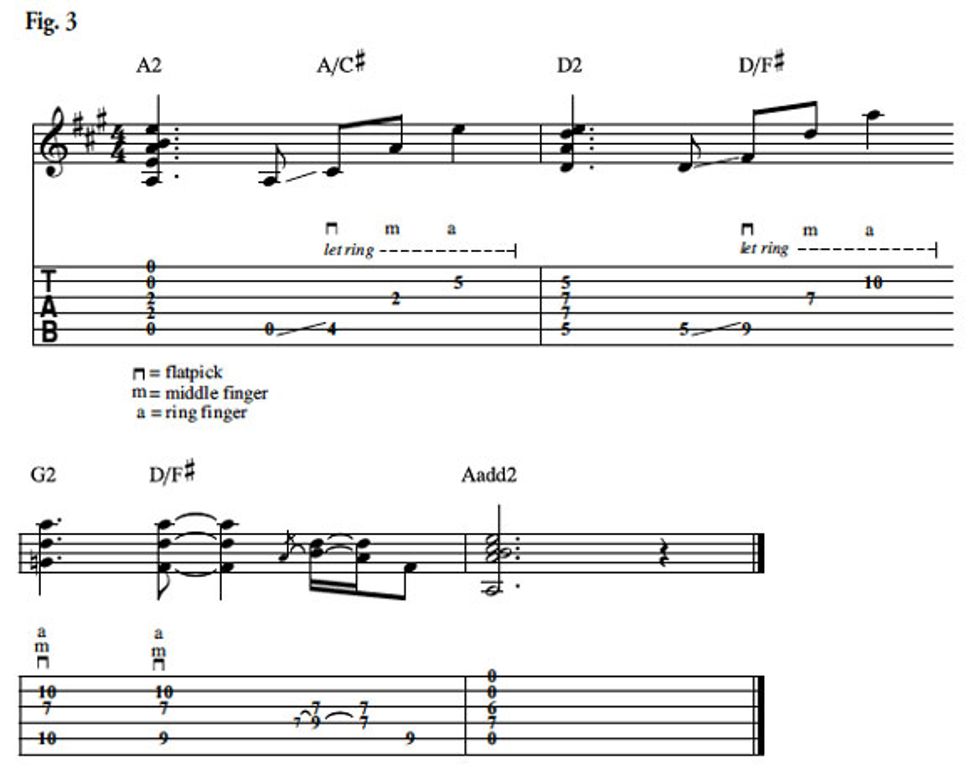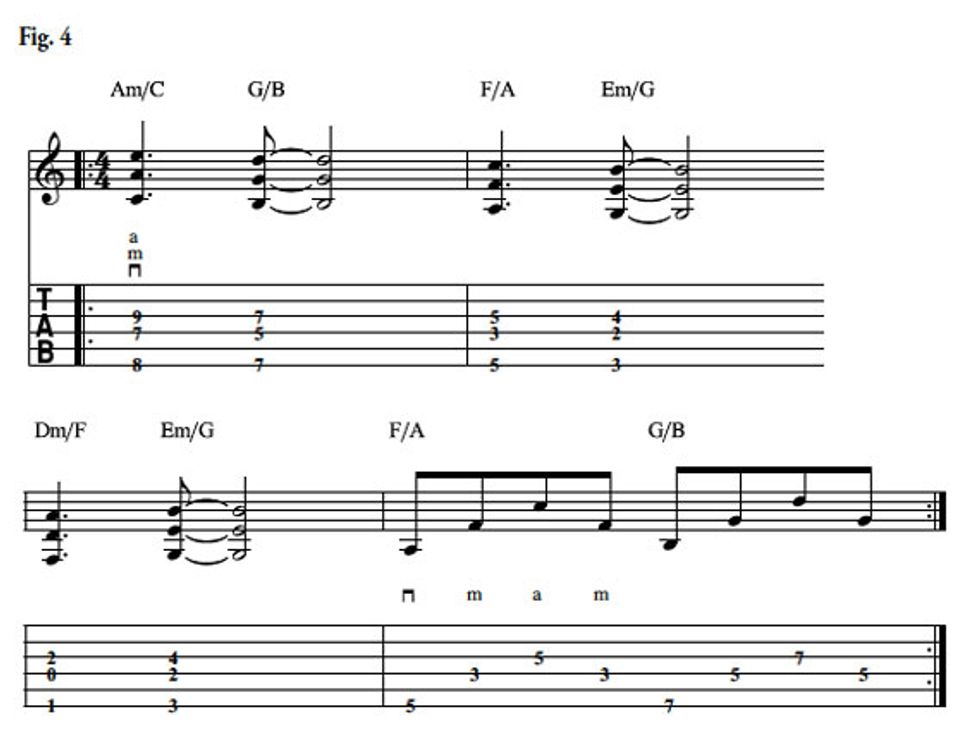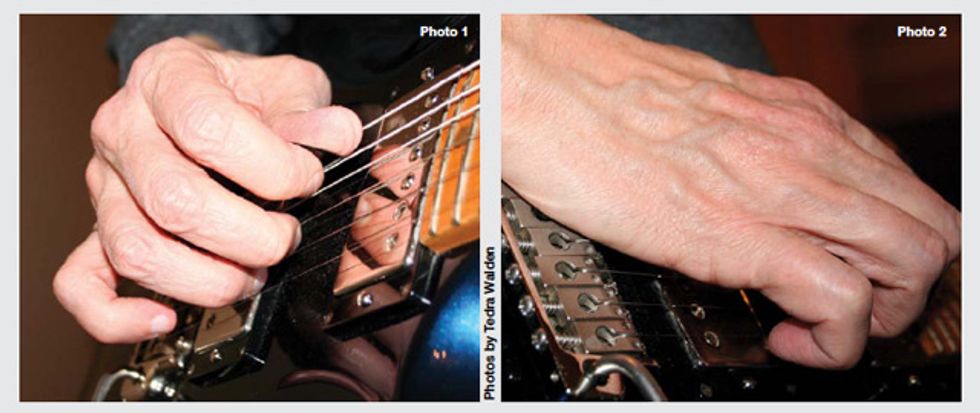Beloved by hot-rod country
and rock guitarists alike,
hybrid picking combines the
power and speed of flatpicking
with some benefits of a purely
fingerstyle approach, such as
being able to weave arpeggios
across non-adjacent strings or
simultaneously strike chord tones
for a piano-like sound. (For
details on this versatile technique,
see “Hybrid Picking 101” on page 2.) But compared
to a four-digit classical or jazz
fingerstyle technique, hybrid
picking has several limitations.
The most obvious is that when
playing chords, this pick-plus-two-
fingers system lets you attack
only three notes at a time.
Most guitarists who use
hybrid picking shift between
a full-on flatpick and a pick-and-fingers approach on the fly.
While this offers a huge timbral
palette, it can be tough to balance
the big, chimey sound of
strummed five- and six-string
chords with the thinner tone of
plucked three-string chords. One
way to beef up the latter is to
use special three-note voicings
that are spread out across a wider
range than the typical triads you
might otherwise grab. It’s easy
to generate “hybrid-friendly”
chords, once you know the
process.
We’ll begin by modifying
standard root-3rd-5th triads,
which always occupy a single
octave. To make these triads
sound bigger, we simply move
the middle note—the 3rd (or
in the case of a minor triad, the b3rd)—down or up an octave,
while leaving the root and 5th in
the same register. In this lesson,
we’ll discover what happens when
we drop the 3rd an octave lower.
Next time around, we’ll focus on
raising the 3rd one octave higher.
Either way, the resulting open
triads span more than an octave.
Download Example Audio 1...

Fig. 1 illustrates the process, beginning with a root-3rd-5th A triad in the 5th position. First, strum A on strings 4, 3, and 2 as written. Next, using hybrid picking, pluck the A/C#—the second chord in our example. Musically, only one thing has changed: We’ve dropped the middle note, our 3 (C#), down an octave. But to fret this new chord, we’ve had to refinger the voicing. In this instance, the root migrates from the 4th to the 3rd string. Though the root has moved, its pitch hasn’t changed.
Incidentally, when a chord’s lowest note is not the root, the harmony is typically written as a slash chord with the chord name on the left and the special bass note on the right. Most slash chords have the 3rd (or b3rd) in the bass, but the 5th and other chord tones can show up here too. (You can even have nonchord tones in the bass, but that’s a topic for another column.)
Now, repeat the process for the second pair of chords in this example, Am and Am/C. Here, we’re pulling the b3rd (C) from inside Am and dropping it down an octave. As you play both chords, listen carefully and compare their relative sonic “weight.” With its expanded range, Am/C sounds bigger than its more compact sibling, although without the root as the lowest note, it can also sound more ambiguous. It’s good to keep these qualities in mind when arranging music with slash chords.
Pushing on, we tackle E and Em, pulling out G# and G (the 3rd and b3rd, respectively) and dropping them an octave to create E/G# and Em/G voicings.
Fig. 2 gives us an alternative visual perspective on the four new voicings we’ve created. We can clearly see that the only difference between A/C# and Am/C, or E/G# and Em/G is the half-step shift that results from moving the 3rd to the b3rd. Perhaps you’ve played these chords before. If not, take a minute to chase them up and down the fretboard, and then hop back and forth between the grips on string sets 5–3–2 and 6–4–3.
Download Example Audio 2...

Now, let’s put our chords to work. Fig. 3 contains strummed four- and five-note chords (A2, D2, and the Aadd2 at the end), as well as plucked three-note voicings. Pay attention to the picking-hand markings for A/C#, D/F#, and G2. In bar 3, we get a piano-like effect by simultaneously plucking the notes in G2 and D/F#. It’s a sound you can’t get using a flatpick alone. As you play through this example, notice the variety of picking-hand textures: full strums, arpeggios, and piano stabs. Also, in bars 1 and 2, notice how the lowest note in each slash chord lies a half-step below the root of the subsequent chord and how strongly one leads to the other.
Download Example Audio 3...

Fig. 4 consists entirely of hybrid-friendly slash chords voiced on strings 6, 4, and 3. To accentuate the root in any of these chords, simply yank the 4th string a little harder—that will do the trick. Try this progression with some slow flanging or modulated delay.
Download Example Audio 4...

In this lesson, we’ve created new voicings by dropping the middle note of a root-3rd-5th triad down an octave. Next month, we’ll see what happens when we push the middle note up an octave. Meanwhile, use these chords to create some progressions of your own.
Hybrid Picking 101
A marriage of fingerpicking and flatpicking, hybrid picking offers elements of both techniques, but replaces neither. Photo 1 shows the basic hybrid picking hand position, which involves attacking the strings using a flatpick plus middle and ring fingers. Here, my pick is hitting the 5th string, and my middle and ring fingers are plucking the 3rd and 2nd strings.

With a classical or jazz fingerstyle technique, your wrist is arched, your hand is open, and your picking fingers are relaxed and extended. With hybrid picking, however, your wrist is flat, your hand rides low, and your middle and ring fingers are tightly curled as they engage the strings. It’s the flatpick that determines this close-in hand position. Curled like this, your picking fingers pull up on the strings, rather than stroking across them (as they would in more traditional fingerpicking). This pulling creates a snappy, popping tone that’s at the heart of country, rockabilly, and other twangy styles.
For a percussive effect, use the back edge of your picking hand to mute the bass strings as you flatpick them (Photo 2). Palm-muting also helps you prevent unwanted open strings from ringing out as you dig into the notes you’re aiming for. When muting, rest your hand lightly on the bridge, so you’ll be able to scoot quickly and easily along the saddles as your lines move from bass to treble strings and back again. Two more benefits: A light touch is better for your tendons and allows your guitar to resonate more freely for maximum sustain.
Andy Ellis is a veteran guitar journalist and Senior Editor at PG. Based in Nashville, Andy backs singer-songwriters on the baritone guitar, and also hosts The Guitar Show, a weekly on-air and online broadcast. For the schedule, links to the stations’ streams, archived audio interviews with inspiring players, and more, visit theguitarshow.com.












![Rig Rundown: Russian Circles’ Mike Sullivan [2025]](https://www.premierguitar.com/media-library/youtube.jpg?id=62303631&width=1245&height=700&quality=70&coordinates=0%2C0%2C0%2C0)













